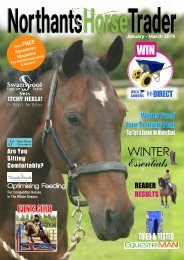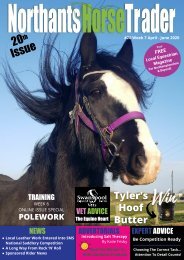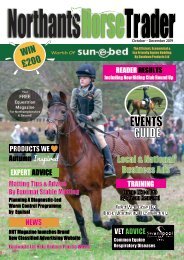NHT Magazine Spring 2018
Create successful ePaper yourself
Turn your PDF publications into a flip-book with our unique Google optimized e-Paper software.
Veterinary Advice…<br />
BREEDING FROM YOUR MARE<br />
What you need to know…<br />
Breeding a foal of your<br />
own is becoming more<br />
fashionable due to the<br />
convenience of “AI at<br />
home”, but have you<br />
considered all the facts?<br />
The foal pictured above is the gorgeous ‘Saffy’ - a homebred foal in Northamptonshire<br />
by Sue Griggs & Kim Taylor. Photo credit to Claire Hirst Photography<br />
Is the mare a suitable mother?<br />
Many aspects are inherited, for example temperament and conformation, i.e.<br />
flat feet, navicular, bad teeth, joint problems and much more. There is still<br />
debate whether headshaking, sarcoids and some stable vices are also inherited.<br />
Is she reproductively sound?<br />
Often it is the older mare recruited to have a foal. However with age the ovaries<br />
may become less active, the uterus a less receptive environment and her<br />
‘reproductive conformation’ may cause her to be more susceptible to<br />
developing complications after insemination.<br />
Is the stallion really what you are looking for?<br />
Obviously looks are very important but remember he will provide half of the<br />
DNA for the foal. Have you chosen him for his athletic potential? Do you want<br />
a competition or a show horse, do you want ‘more bone’ or ‘more speed’? But<br />
also remember he will influence all of the same inherited considerations<br />
mentioned before, including temperament and conformation.<br />
Have you considered the timescale?<br />
A mare successfully bred today should be rested for 40 days then can be<br />
returned to a reasonable level of exercise up to around 6 months of pregnancy.<br />
After foaling, at 11 months & 10 days, the mare needs to nurse the foal until<br />
about 6 months of age. Only at this time should the foal be weaned and the<br />
mare returned to work. If necessary she can be re-covered from as early as<br />
9 days after foaling. The foal realistically now needs to be turned away to<br />
mature until breaking at around 3 years old, dependent upon breed.<br />
How much will it cost?<br />
Assuming there are no complications then you should budget for 3<br />
cycles/attempts of the mare conceiving and the vets fees associated with this.<br />
Remember the livery fees if away at stud will include at least a 28 day scan<br />
post conceiving, and possibly a 42 day scan. A stallion ‘nomination’ fee,<br />
whether natural, fresh, chilled or frozen (including transport and storage).<br />
On foaling, winter feed, rugs and bedding. Stabling and veterinary fees at<br />
foaling. Registration, passport and microchipping. Worming, vaccinations,<br />
insurance, weaning, castration, farriery, dentistry, also possibly wolf tooth<br />
removal. Then sending away for breaking and schooling. Only then might you<br />
have a saleable commodity but do not imagine it will cover the above costs,<br />
this is a labour of love!<br />
23<br />
How do I proceed from here?<br />
Assuming the mare is healthy and has to go away to stud she will need swabs<br />
and blood samples taking to make sure she is clear of venereal diseases.<br />
These take at least 10 days to be processed. Once at stud she may be “short<br />
cycled” to encourage her to return into season ‘in the next few days’, to help<br />
speed the process up.<br />
What happens at stud?<br />
When in season she will be examined repeatedly over the following few days<br />
to ascertain the optimum time for covering or insemination. Once impregnated<br />
she will be checked to ensure she is clean inside, then checked at 16-18 days<br />
and if pregnant scanned again at 28 days for a foetal heart beat and a further<br />
scan at 42 days. Did you know that while a natural mating may produce viable<br />
semen living for up to 5 days, frozen semen, once thawed and inseminated,<br />
may only live for 6 hours, just like the unfertilised egg! Thus timing is critical.<br />
This explains the necessity for so many visits.<br />
Should I use AI or Natural?<br />
Usually you will not have a choice! Internet stallions may only supply frozen<br />
semen, stored at -176C, but some will offer chilled semen due to having a<br />
better fertility rate. However, whichever method you chose it is imperative that<br />
the semen comes with a fully comprehensive health certificate, ensuring it is<br />
free from all contagious diseases.<br />
Advantages of AI include:<br />
Less need to travel mares or put them at risk from being exposed to infections<br />
or injury. Greater choice of stallions from all over the world.<br />
Advantages of Natural covering:<br />
Cheaper and the only recognised method of mating registered Thoroughbred<br />
mares.<br />
Too Posh To Push?<br />
Embryo Transfer may be the answer for competing mares but this is very<br />
expensive and should ideally be undertaken at a specialist facility. It entails<br />
washing out a 7 day old fertilised embryo from the mare then implanting it into<br />
a recipient surrogate mare for the next 11 months.<br />
Still interested?<br />
Start soon as the breeding season starts in the spring. Feel free to ring the<br />
practice on 01933 222145 to discuss with us your mare’s needs for the <strong>2018</strong><br />
breeding season and set the ball rolling soon.<br />
Note: The photo is for illustration purposes only and has no connection to the magazine or Swanspool Equine Clinic















